Glass Gem Is A Unique Strain Of Corn With Kernels That Look Like Pieces Of Rainbow-colored Glass. Source
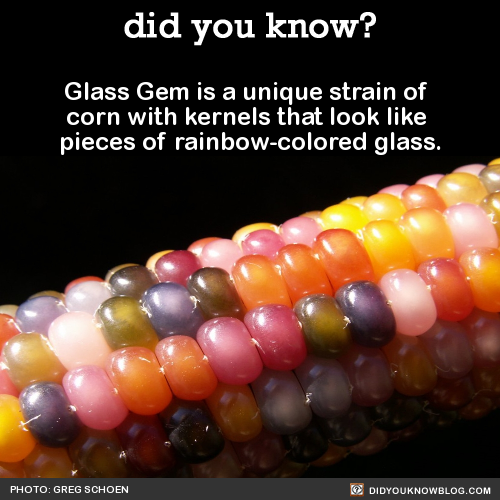
Glass Gem is a unique strain of corn with kernels that look like pieces of rainbow-colored glass. Source

Carl Barnes, an Oklahoma farmer, started growing older corn varieties to connect with his Cherokee heritage.


He isolated ancestral strains Native American tribes lost in the 1800s when they were relocated to Oklahoma.


Soon he began exchanging ancient corn seed with growers from all over the country, while simultaneously saving and replanting seeds from the most colorful cobs.

This eventually resulted in rainbow-colored corn.

When the rainbow corn mixed with the traditional varieties it created new strains, displaying more vibrant colors and patterns over time.


Glass Gem is a flint corn, so it isn’t really eaten off the cob. It’s usually ground into cornmeal and used in tortillas or grits, but it can also be used to make popcorn.

If you love corn and rainbows, seeds can be purchased online for about $7.95.

More Posts from Aspergers1044 and Others
According to a recent study, adolescents with Autism Spectrum Disorders (ASD) show an atypical amount of increased functional connectivity in brain networks that are crucial for social recognition. A group of researchers from San Diego State University compared the brain networks of 25 individuals...

This could be The First Confirmed Astronomical Discovery of an Extrasolar_Moon more than 20_Years after The First Confirmed Astronomical Discovery of an Extrasolar_Planet was made!
Publishers are giving away Bestselling Books for Free!
Last year, Random House decided to give away Dan Brown’s bestselling novel, The Da Vinci Code, for free for one week. The eBook freebie ran on the 10-year anniversary of The Da Vinci Code, and a few weeks before the release of Brown’s new book, Inferno.
Why did Random House give away a...
Different Types of Supernovae are the Primary Origins of Different Classes of Chemical_Elements.
You Are Made of Stardust
Though the billions of people on Earth may come from different areas, we share a common heritage: we are all made of stardust! From the carbon in our DNA to the calcium in our bones, nearly all of the elements in our bodies were forged in the fiery hearts and death throes of stars.
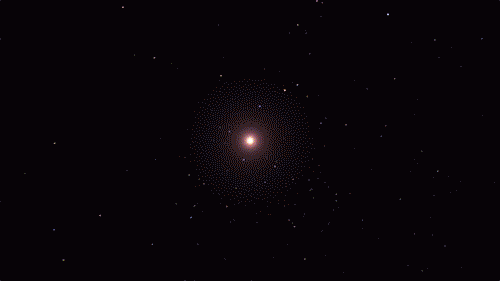
The building blocks for humans, and even our planet, wouldn’t exist if it weren’t for stars. If we could rewind the universe back almost to the very beginning, we would just see a sea of hydrogen, helium, and a tiny bit of lithium.
The first generation of stars formed from this material. There’s so much heat and pressure in a star’s core that they can fuse atoms together, forming new elements. Our DNA is made up of carbon, hydrogen, oxygen, nitrogen, and phosphorus. All those elements (except hydrogen, which has existed since shortly after the big bang) are made by stars and released into the cosmos when the stars die.

Each star comes with a limited fuel supply. When a medium-mass star runs out of fuel, it will swell up and shrug off its outer layers. Only a small, hot core called a white dwarf is left behind. The star’s cast-off debris includes elements like carbon and nitrogen. It expands out into the cosmos, possibly destined to be recycled into later generations of stars and planets. New life may be born from the ashes of stars.
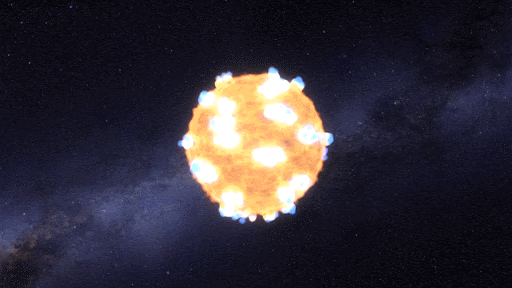
Massive stars are doomed to a more violent fate. For most of their lives, stars are balanced between the outward pressure created by nuclear fusion and the inward pull of gravity. When a massive star runs out of fuel and its nuclear processes die down, it completely throws the star out of balance. The result? An explosion!
Supernova explosions create such intense conditions that even more elements can form. The oxygen we breathe and essential minerals like magnesium and potassium are flung into space by these supernovas.
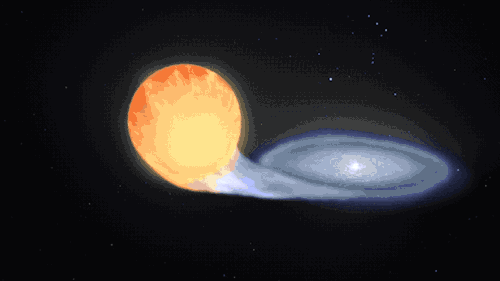
Supernovas can also occur another way in binary, or double-star, systems. When a white dwarf steals material from its companion, it can throw everything off balance too and lead to another kind of cataclysmic supernova. Our Nancy Grace Roman Space Telescope will study these stellar explosions to figure out what’s speeding up the universe’s expansion.
This kind of explosion creates calcium – the mineral we need most in our bodies – and trace minerals that we only need a little of, like zinc and manganese. It also produces iron, which is found in our blood and also makes up the bulk of our planet’s mass!

A supernova will either leave behind a black hole or a neutron star – the superdense core of an exploded star. When two neutron stars collide, it showers the cosmos in elements like silver, gold, iodine, uranium, and plutonium.

Some elements only come from stars indirectly. Cosmic rays are nuclei (the central parts of atoms) that have been boosted to high speed by the most energetic events in the universe. When they collide with atoms, the impact can break them apart, forming simpler elements. That’s how we get boron and beryllium – from breaking star-made atoms into smaller ones.
Half a dozen other elements are created by radioactive decay. Some elements are radioactive, which means their nuclei are unstable. They naturally break down to form simpler elements by emitting radiation and particles. That’s how we get elements like radium. The rest are made by humans in labs by slamming atoms of lighter elements together at super high speeds to form heavier ones. We can fuse together elements made by stars to create exotic, short-lived elements like seaborgium and einsteinium.
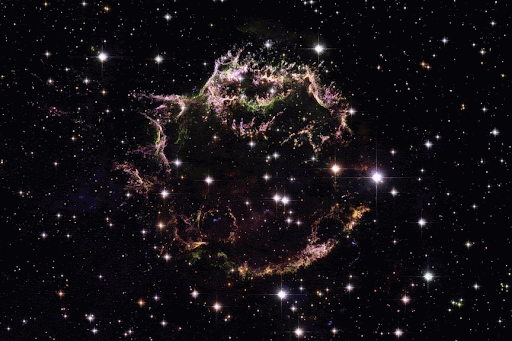
From some of the most cataclysmic events in the cosmos comes all of the beauty we see here on Earth. Life, and even our planet, wouldn’t have formed without them! But we still have lots of questions about these stellar factories.
In 2006, our Stardust spacecraft returned to Earth containing tiny particles of interstellar dust that originated in distant stars, light-years away – the first star dust to ever be collected from space and returned for study. You can help us identify and study the composition of these tiny, elusive particles through our Stardust@Home Citizen Science project.
Our upcoming Roman Space Telescope will help us learn more about how elements were created and distributed throughout galaxies, all while exploring many other cosmic questions. Learn more about the exciting science this mission will investigate on Twitter and Facebook.
Make sure to follow us on Tumblr for your regular dose of space!
Here are The Top_Ten Star_Wars Planets!
(via https://www.youtube.com/watch?v=SqHGZu0DBag)
IT'S TIME AGAIN TO TAKE A CENSUS OF THE U.S. POPULATION.
MAKE SURE THAT YOU'RE COUNTED!
2020 Census: Everyone Counts
It’s that time again. Census time! Once every ten years the federal government counts every single person living in the U.S. of A. in order to effectively allocate representation and resources across the country. It’s an ambitious endeavor, for sure, but one designed to benefit everyone by making sure each community can adequately fund crucial public goods and services, like roads, hospitals, and schools. It determines how many seats each state gets in the U.S. House of Representatives. Also, congressional and state legislative boundaries are drawn and redrawn based on the data collected. Political representation at the state and federal level hinges on census participation. That’s a big deal!
The census count kicked off in March, with its biggest push for people to respond on their own in April, a.k.a. tax month. Although people in the U.S. pay federal income taxes every year, only once every decade do we have the power to influence how those dollars come back to us
The census is a nine-part questionnaire that takes just 10 minutes to complete. To combat all the misinformation flying around about what the census is and how the collected data is used, we’re gonna bust some of the myths and answer a few of the frequently asked questions:
Is there a citizenship question?
No. The courts have permanently blocked asking respondent their citizenship status and the courts have permanently blocked the Trump administration from adding one. Furthermore, federal law prohibits the Census Bureau from sharing individual census information with any person, organization or government body, including law enforcement. Your responses can only be used for statistical purposes (individual records are released only after 72 years!).
What will you be asked?
The questionnaire asks for basic demographic information such as age, race, type of housing, etc. It will not ask for compromising or sensitive information like social security numbers, bank account numbers, or immigration status.
Who should be counted on the Census?
Every person living in the United States, regardless of citizenship status, including kids and babies!
How can I take the Census?
Great news! Completing the census questionnaire is literally the easiest it’s ever been. For the first time ever, you can complete the census online at 2020Census.gov or by phone at 844-330-2020. Also, by April 1st, every home will receive a mailed notice to participate in the 2020 Census.
When is the deadline?
Ideally, Uncle Sam would like to receive your data by April 30th. But as of right now, you can respond on your own all the way until mid-August. If you don’t respond on your own by the end of May, a Census worker may come to your home and ask to record your answers in person. And while it was funny on screen, please do not behave like Christopher Walken in this classic SNL Census sketch.
Is it safe?
Yes. The census is safe, your information is handled with the utmost confidentiality meaning that no one can take your data and use it against you. Your individual data will not be shared with any person, organization or government body, including other federal agencies or any law enforcement or housing authorities. It’s to your benefit to participate.
Sure, filling out a form sounds boring, but it helps to think of it as an opportunity to make your voices heard in a way that really matters. That sounds exciting, no? Plus, you only have to spend 10 minutes doing it once every 10 years.
Make sure to pass this information to your friends and family in order to stop the spread of misinformation. If you have any questions, please check out the United States Census Bureau Fact Sheet.
Please visit 2020census.gov for more information.
I would sure like to see something like The Hyperloop or Evacuated Tube Technology come to be a common form of Long-Distance Travel someday!

MIT Reveals its Version of Hyperloop Transit Pod
Tired of being stuck in traffic on the highway or waiting endlessly for a delayed subway? Almost three years ago, Elon Musk envisioned the Hyperloop, a new type of public transit that would whisk commuter-filled pods efficiently across hundreds of kilometers in a matter of minutes via tubes; and of course, only second to teleportation in terms of overall coolness.
Among a number of startups trying to get in on the competition sponsored by Musk’s company SpaceX, a student team from the Massachusetts Institute of Technology emerged earlier this year as the front-runner when it won the competition’s design phase. On Friday, MIT finally unveiled the prototype pod that it will test this summer at a 1-mile racetrack near SpaceX’s headquarters in Hawthorne, California.
Photograph by MIT
There could be other universes out there in The Cosmos.
-
 heckcareoxytwit liked this · 1 month ago
heckcareoxytwit liked this · 1 month ago -
 cayoe liked this · 2 months ago
cayoe liked this · 2 months ago -
 tanukutie reblogged this · 3 months ago
tanukutie reblogged this · 3 months ago -
 tanukutie liked this · 3 months ago
tanukutie liked this · 3 months ago -
 kintsugaheart reblogged this · 6 months ago
kintsugaheart reblogged this · 6 months ago -
 at-least-ill-die-a-lionturtle liked this · 8 months ago
at-least-ill-die-a-lionturtle liked this · 8 months ago -
 soleburneus reblogged this · 11 months ago
soleburneus reblogged this · 11 months ago -
 kipowolfton liked this · 1 year ago
kipowolfton liked this · 1 year ago -
 official-corn-posts reblogged this · 1 year ago
official-corn-posts reblogged this · 1 year ago -
 orbweaselart liked this · 1 year ago
orbweaselart liked this · 1 year ago -
 surprisinglyfriendlybirds liked this · 1 year ago
surprisinglyfriendlybirds liked this · 1 year ago -
 cigarettestreetlight liked this · 1 year ago
cigarettestreetlight liked this · 1 year ago -
 heckcareoxytwit reblogged this · 1 year ago
heckcareoxytwit reblogged this · 1 year ago -
 blk-vixen liked this · 1 year ago
blk-vixen liked this · 1 year ago -
 chromium235 liked this · 1 year ago
chromium235 liked this · 1 year ago -
 akirakan reblogged this · 1 year ago
akirakan reblogged this · 1 year ago -
 heckcareoxytwit reblogged this · 1 year ago
heckcareoxytwit reblogged this · 1 year ago -
 8bit-anxiety liked this · 1 year ago
8bit-anxiety liked this · 1 year ago -
 featheredneststudio liked this · 1 year ago
featheredneststudio liked this · 1 year ago -
 sir-david-von-templo liked this · 2 years ago
sir-david-von-templo liked this · 2 years ago -
 swimmingcomicbookscomicsflap liked this · 2 years ago
swimmingcomicbookscomicsflap liked this · 2 years ago -
 redd956 liked this · 2 years ago
redd956 liked this · 2 years ago -
 oxymitch-archive reblogged this · 2 years ago
oxymitch-archive reblogged this · 2 years ago -
 believe-blogs-and-reblogs reblogged this · 2 years ago
believe-blogs-and-reblogs reblogged this · 2 years ago -
 rosesonapond liked this · 2 years ago
rosesonapond liked this · 2 years ago -
 justremainingmyself liked this · 2 years ago
justremainingmyself liked this · 2 years ago -
 horadoismais liked this · 2 years ago
horadoismais liked this · 2 years ago -
 butteryyy reblogged this · 2 years ago
butteryyy reblogged this · 2 years ago -
 monsterlogic reblogged this · 2 years ago
monsterlogic reblogged this · 2 years ago -
 ladyoctopus reblogged this · 2 years ago
ladyoctopus reblogged this · 2 years ago -
 potential-writing-material20 reblogged this · 2 years ago
potential-writing-material20 reblogged this · 2 years ago -
 whimsical-adhd-gal-pal-1910 liked this · 2 years ago
whimsical-adhd-gal-pal-1910 liked this · 2 years ago -
 potatoes-are-magic reblogged this · 2 years ago
potatoes-are-magic reblogged this · 2 years ago -
 tomboy014 liked this · 2 years ago
tomboy014 liked this · 2 years ago -
 daphnectar liked this · 2 years ago
daphnectar liked this · 2 years ago -
 one-time-i-jumped-off-a-cliff liked this · 2 years ago
one-time-i-jumped-off-a-cliff liked this · 2 years ago -
 writersblocksblastingcaps reblogged this · 2 years ago
writersblocksblastingcaps reblogged this · 2 years ago -
 kknath2011 liked this · 2 years ago
kknath2011 liked this · 2 years ago

